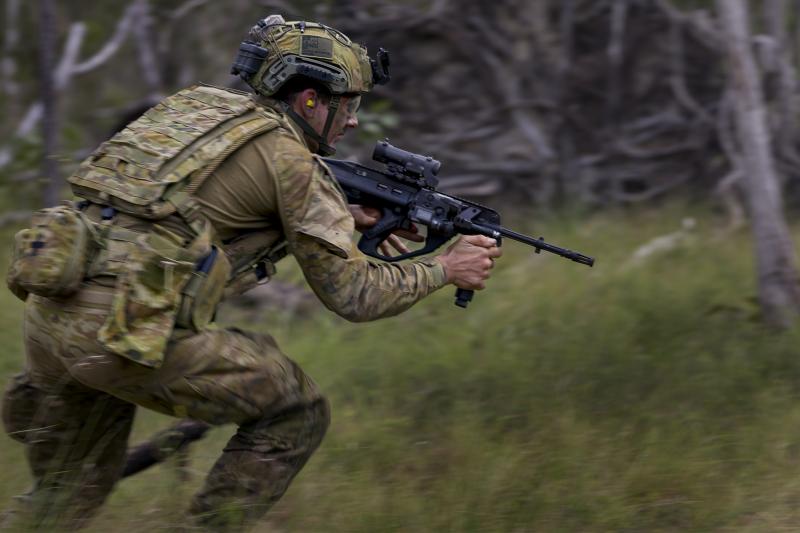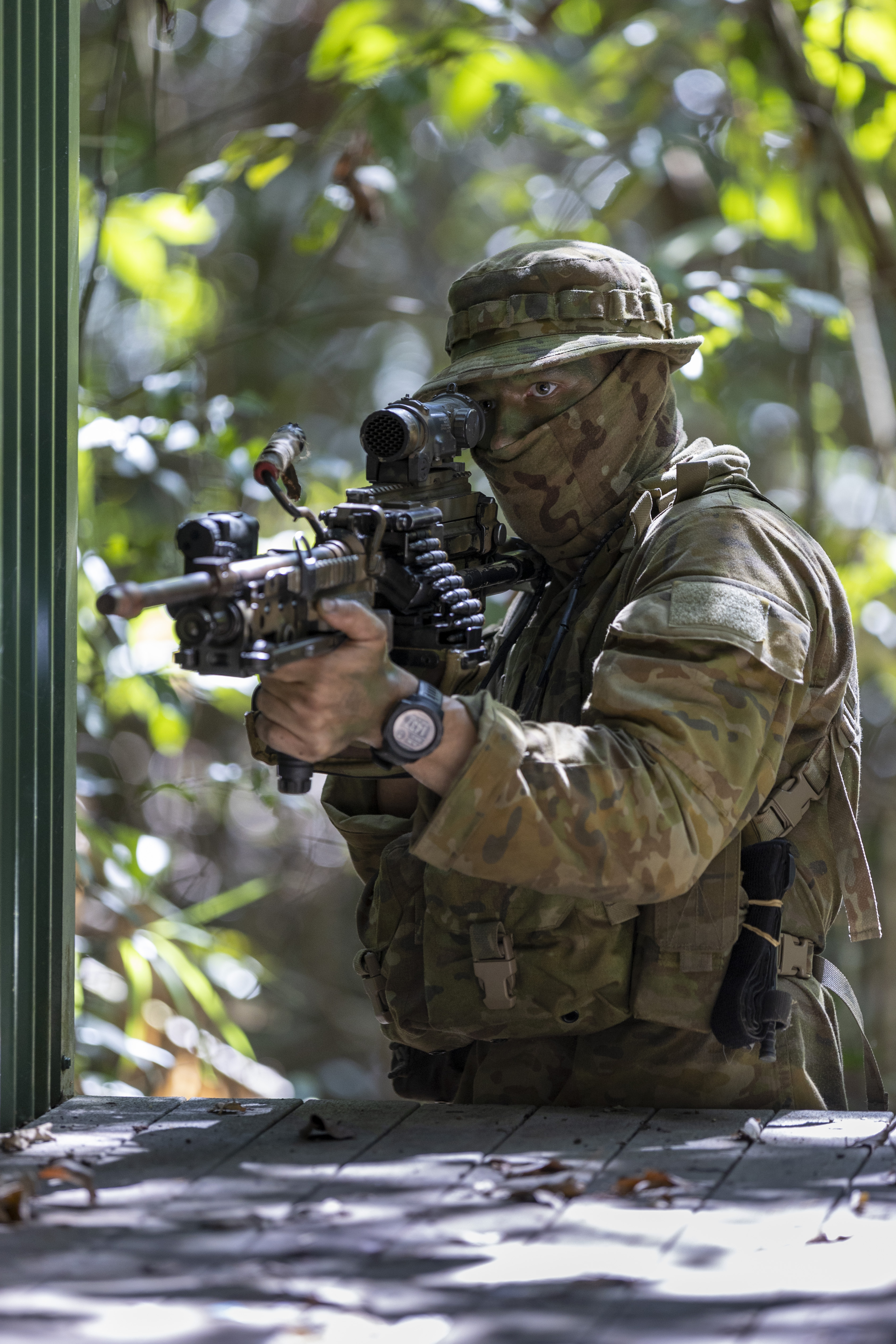Introduction.
Modern combatant training is constantly challenged by the dynamic contemporary operating environment. The School of Infantry is answering this challenge. The new Combatant Training Continuum offers a world-class solution for training modern combatants. It instils a Combat Mindset, that inculcates Combat Behaviours, and encompasses three core Programs: the Army Combatives Program (ACP), the Close Combat Shooting Program (CCSP) and the Combat Marksmanship Program (CMP). An evolved training methodology also guides the teaching of these programs. The Combatant Training Continuum is the product of hard learned lessons by partner militaries and Australian close combatants—those that seek out and close with the enemy.
The challenge
Technology has empowered our adversaries to upskill their close combatants. Lessons shared through everyday communications—Internet and phone services—allow adversaries to reach new levels of tactical proficiency, improve their individual weapons skills and develop other competencies. Through this collaboration our adversaries diminish our edge on the battlefield. Therefore, to maintain the edge we must refine our close combatant skills.
International peer military forces share this challenge. The Special Operations community has deep ties with partner organisations, and these relationships have fielded best-practice. This learning has been communicated to the Royal Australian Regiment, which is poised to deliver it to the entire Australian Army though a coherent and logical training continuum. This continuum has three parts: the overarching Combat Mindset philosophy, the three core Programs and Enhanced Instructional Techniques. The Combat Mindset, with Combat Behaviours, is at the core of the continuum; the Programs are the means to development; and the Enhanced Instructional Methods are best-practice teaching methodologies employed within the Programs.
The Combat Training Continuum
The development of the Combatant Training Continuum was a collaborative approach, informed by Special Operations Command and developed with School of Infantry, 1st Battalion the Royal Australian Regiment and 1st Recruit Training Battalion. Whilst the Royal Australian Regiment is the primary stakeholder, the utility and application of the continuum cuts across all corps. To reflect this, combatants are divided into two groups: Foundation Combatants (All Corps) and Enhanced Combatants (Infantry). School of Infantry has trained over two hundred Enhanced Combatants since the continuum was launched in July 2017 .
So what does it look like? As shown below, every combatant achieves the Foundation Combatant standard. Then, as appropriate, Enhanced Combatants are developed at School of Infantry or within Combat Brigades.

Combat Mindset
The Combat Mindset, executed through Combat Behaviours, is at the heart of the Combatant Training Continuum. The Combat Mindset is a state of mind that prepares combatants to kill the enemy and survive, then continue the fight. It identifies the combatant, not their tools, as the weapon. This mindset is executed through Combat Behaviours: intuitive responses, or immediate action drills prompted by actions in the battlespace. These Combat Behaviours fall neatly across the continuum, unifying critical programs to optimally prepare combatants for conflict.
Programs
First, the Army Combatives Program provides the skills for the extremely close fight. Precision weapons and equipment have not eliminated the need to close with the enemy in close quarters combat. The Australian Army has recognised this enduring need, exemplified by Military Self Defence. However, recent lessons suggest that Military Self Defence is not optimal to instil simple ‘immediate action’ responses that are available intuitively in combat. The Army Combatives Program is the next generation. The program has three levels: Level 1 (ab initio), Level 2 (All Corps) and Level 3 (Infantry). Through these levels, a coherent and minimised suite of drills and movements are taught.
Next, instinctive Combat Behaviours are expanded from the close fight through the Close Combat Shooting Program. Close combatants are taught to employ the in-service rifle and the in-service pistol seamlessly in a firefight. The Enhanced Combat Shooting Course (for infantry combatants) provides these skills. A bias for situational awareness, judicious lethality and precise drills to ensure survivability is ingrained—achieving not just competence, but proficiency.
Effective engagement of threats at extended ranges is the culmination of enhanced combatant training in the Combatant Training Continuum. The Combat Marksmanship Program provides the platform to perfect Combat Behaviours taught in earlier programs. This program evolves the Live Fire practices into Rifle Practices 1 to 6, with a separate 3A and 6A as the assessment practices.
The Combat Marksmanship Program is unique in a number of ways. Firstly, serials are initiated with fire control orders and realistic and reactive targetry is employed. Then, threats present across multiple distances and in multiples; presenting a dilemma for combatants. Successful combatants achieve high scores in accuracy and do so while demonstrating Combat Behaviours. This enables combatants to hone the Combat Mindset rather than conduct target practice.

Enhanced Instructional Techniques
Enhanced Instructional Techniques, particularly Reality Based Training, is the unifying training methodology executed within the Army Combatives Program and the Close Combat Shooting Program. Each individual student is the focus of tailored instruction, informed by an understanding of how the brain learns and an emphasis on small group instruction. Placed in realistic scenarios, combatants mentally search through a catalogue[1] of experiences, to affirm their Combat Behaviours.
Well-orchestrated role-play requires competent instructors to create realistic scenarios. A scenario may see the combatant confronted by a potential suicide bomber at a checkpoint. As the threat is realised, the combatant has seconds to act, and must act decisively. This learning is amplified with complexity in the scenario, creating a dilemma for the combatant. Socratic questioning (a critical dialogue between instructor and student to stimulate critical thinking and draw out underlying assumptions) is used throughout to enhance learning.
Conclusion
The Combatant Training Continuum is an evolution in combatant training. The Combat Mindset, with Combat Behaviours, is a philosophy based on extensive experience and practice to promote mastery in the close fight. The continuum employs three unified programs: the Army Combatives Program, the Close Combat Shooting Program and the Combat Marksmanship Program. This continuum will ensure the Royal Australian Regiment maintains its position as a world-class infantry fighting force, and that the wider Australian Army is better able to fight and win the next conflict..









